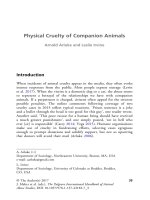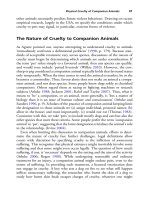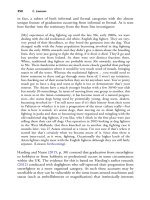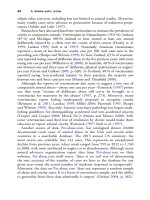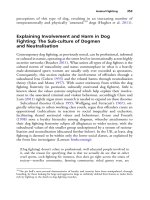The palgrave international handbook of a 181
Bạn đang xem bản rút gọn của tài liệu. Xem và tải ngay bản đầy đủ của tài liệu tại đây (25.72 KB, 1 trang )
Breeding and Rearing Farmed Animals
173
received significant boosts from television chefs such as Jamie Oliver and
Hugh Fearnley-Whittingstall in the UK, who have campaigned on issues of
animal welfare, environmental damage and human health resultant from
intensive farming and aquaculture and have endorsed such food labelling
(Fearnley-Whittingstall 2015; Oliver 2015). Other groups seeking reform
of farming practices include Compassion in World Farming (CIWF) which
campaigns for the abolition of certain methods (such as the use of sow stalls
and tethering in intensive pig production, or the caging of rabbits and
laying hens). More broadly, CIWF wishes to eventually abolish intensive
farming methods, promoting smaller operations based on ‘high’ welfare
standards. CIWF, established by a farmer appalled at the spread of intensive agriculture in 1967, has campaigned with success in the European
Union, securing the recognition of animals as sentient beings, capable of
feeling pain and suffering, and bans for battery cages for egg-laying hens
and sow stalls (CIWF 2015). States, international organisations and even
agribusiness corporations have deployed animal welfare arguments and
combined them with ideas about meat quality in promoting ‘ethical’
branding of meat and other ‘animal products’. However, research has
indicated that there are limits to the welfare that might be secured through
‘welfare quality’ initiatives in the European Union, for example, and that
any ‘gains’ in reducing cruelty towards animals are at best, partial and
ambiguous (Miele and Lever 2013).
Other groups have more radical agendas that support the abolition of the
breeding and rearing of non-human creatures for food and advocate for a
vegetarian or vegan future. For example, the largest UK based animal rights
group, Animal Aid, founded in 1977, ‘promote[s] the adoption of an
animal-free diet as the best single step anyone can take to stop cruelty to
animals’ (Animal Aid 2015) and seeks to raise public awareness about the
cruelties involved in all forms of the raising of non-human animals for food.
The largest animal rights organisation is People for the Ethical Treatment
of Animals (PETA), founded in 1980. Its slogan is ‘animals are not ours to
eat, wear, experiment on, use for entertainment, or abuse in any other way’,
and PETA has a key focus on opposition to factory farming and eating
meat and promoting a vegan diet (PETA 2015). Such organisations have
been critiqued for the tactics they have deployed and for being either
‘excessively’ radical or not radical enough in supporting welfare reform as
strategic in securing an agenda of the abolition of the use of animals for
food. The work of such organisations has been significant in raising public
awareness through investigative campaigns and causing pressure for change
within the industry. The existence of such groups, their expanding
